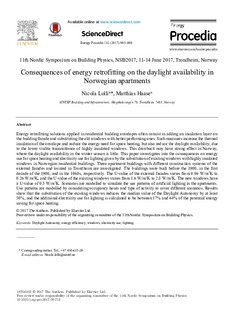| dc.contributor.author | Lolli, Nicola | |
| dc.contributor.author | Haase, Matthias | |
| dc.date.accessioned | 2017-11-28T06:48:21Z | |
| dc.date.available | 2017-11-28T06:48:21Z | |
| dc.date.created | 2017-11-27T09:11:56Z | |
| dc.date.issued | 2017 | |
| dc.identifier.citation | Energy Procedia. 2017, 132 903-908. | nb_NO |
| dc.identifier.issn | 1876-6102 | |
| dc.identifier.uri | http://hdl.handle.net/11250/2468185 | |
| dc.description.abstract | Energy retrofitting solutions applied in residential building envelopes often consist in adding an insulation layer on the building facade and substituting the old windows with better performing ones. Such measures increase the thermal insulation of the envelope and reduce the energy need for space heating, but also reduce the daylight availability, due to the lower visible transmittance of highly insulated windows. This drawback may have strong effect in Norway, where the daylight availability in the winter season is little. This paper investigates into the consequences on energy use for space heating and electricity use for lighting given by the substitution of existing windows with highly insulated windows in Norwegian residential buildings. Three apartment buildings with different construction systems of the external facades and located in Trondheim are investigated. The buildings were built before the 1900, in the first decade of the 1900, and in the 1960s, respectively. The U-value of the external facades varies from 0.96 W/m2K to 0.26 W/m2K, and the U-value of the existing windows varies from 1.6 W/m2K to 2.8 W/m2K. The new windows have a U-value of 0.5 W/m2K. Scenarios are modelled to simulate the use patterns of artificial lighting in the apartments. Use patterns are modelled by considering occupancy hours and type of activity to cover different scenarios. Results show that the substitution of the existing windows reduces the median value of the Daylight Autonomy by at least 50%, and the additional electricity use for lighting is calculated to be between 17% and 64% of the potential energy saving for space heating. | nb_NO |
| dc.language.iso | eng | nb_NO |
| dc.publisher | Elsevier Ltd. | nb_NO |
| dc.rights | Attribution-NonCommercial-NoDerivatives 4.0 Internasjonal | * |
| dc.rights.uri | http://creativecommons.org/licenses/by-nc-nd/4.0/deed.no | * |
| dc.subject | Apartment buildings | nb_NO |
| dc.subject | Artificial lighting | nb_NO |
| dc.subject | Construction systems | nb_NO |
| dc.subject | Daylight autonomies | nb_NO |
| dc.subject | Daylight availability | nb_NO |
| dc.subject | Electricity use | nb_NO |
| dc.subject | Residential building | nb_NO |
| dc.subject | Visible transmittance | nb_NO |
| dc.subject | Apartment houses | nb_NO |
| dc.subject | Energy conservation | nb_NO |
| dc.subject | Energy efficiency | nb_NO |
| dc.subject | Energy utilization | nb_NO |
| dc.subject | Facades | nb_NO |
| dc.subject | Housing | nb_NO |
| dc.subject | Space-heating | nb_NO |
| dc.subject | Thermal insulation | nb_NO |
| dc.subject | Windows | nb_NO |
| dc.title | Consequences of energy retrofitting on the daylight availability in Norwegian apartments | nb_NO |
| dc.title.alternative | Nordic Symposium on Building Physics, NSB 2017, June 11, 2017 | nb_NO |
| dc.type | Journal article | nb_NO |
| dc.type | Peer reviewed | nb_NO |
| dc.description.version | publishedVersion | nb_NO |
| dc.rights.holder | © The authors | nb_NO |
| dc.subject.nsi | VDP::Technology: 500 | nb_NO |
| dc.source.pagenumber | 903-908 | nb_NO |
| dc.source.volume | 132 | nb_NO |
| dc.source.journal | Energy Procedia | nb_NO |
| dc.identifier.doi | 10.1016/j.egypro.2017.09.713 | |
| dc.identifier.cristin | 1518633 | |
| cristin.unitcode | 7401,30,40,0 | |
| cristin.unitname | Arkitektur, byggematerialer og konstruksjoner | |
| cristin.ispublished | true | |
| cristin.fulltext | original | |
| cristin.qualitycode | 1 | |

